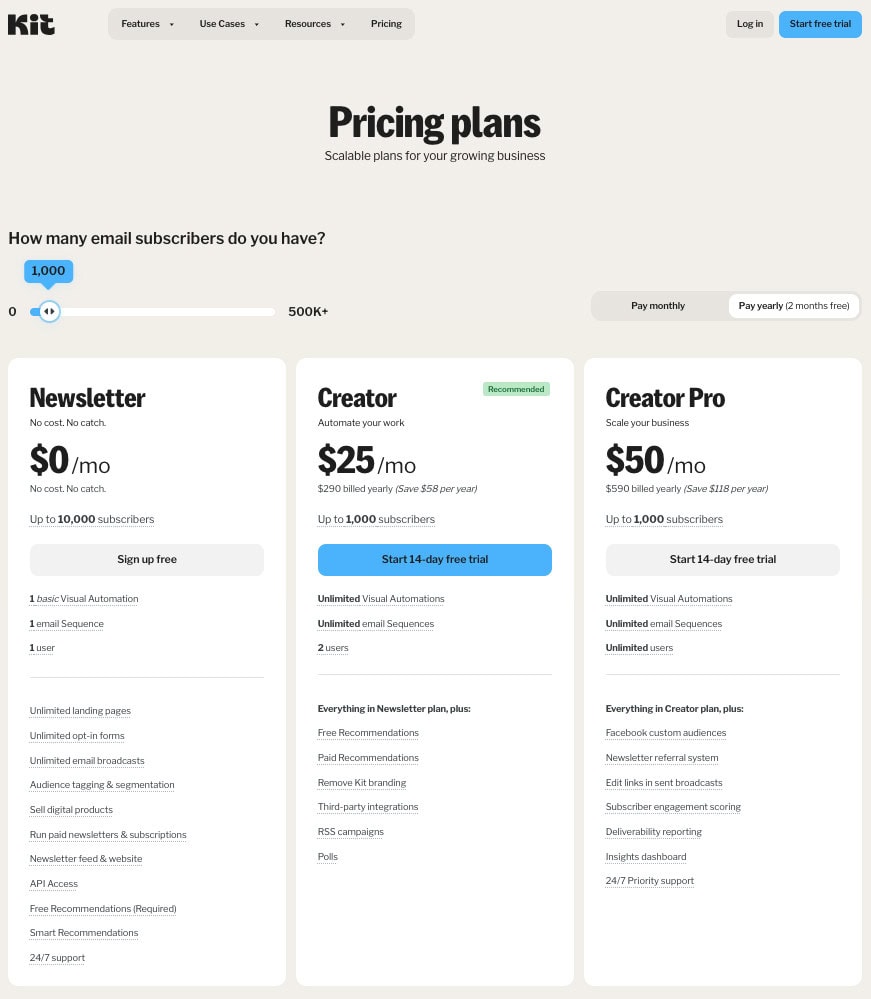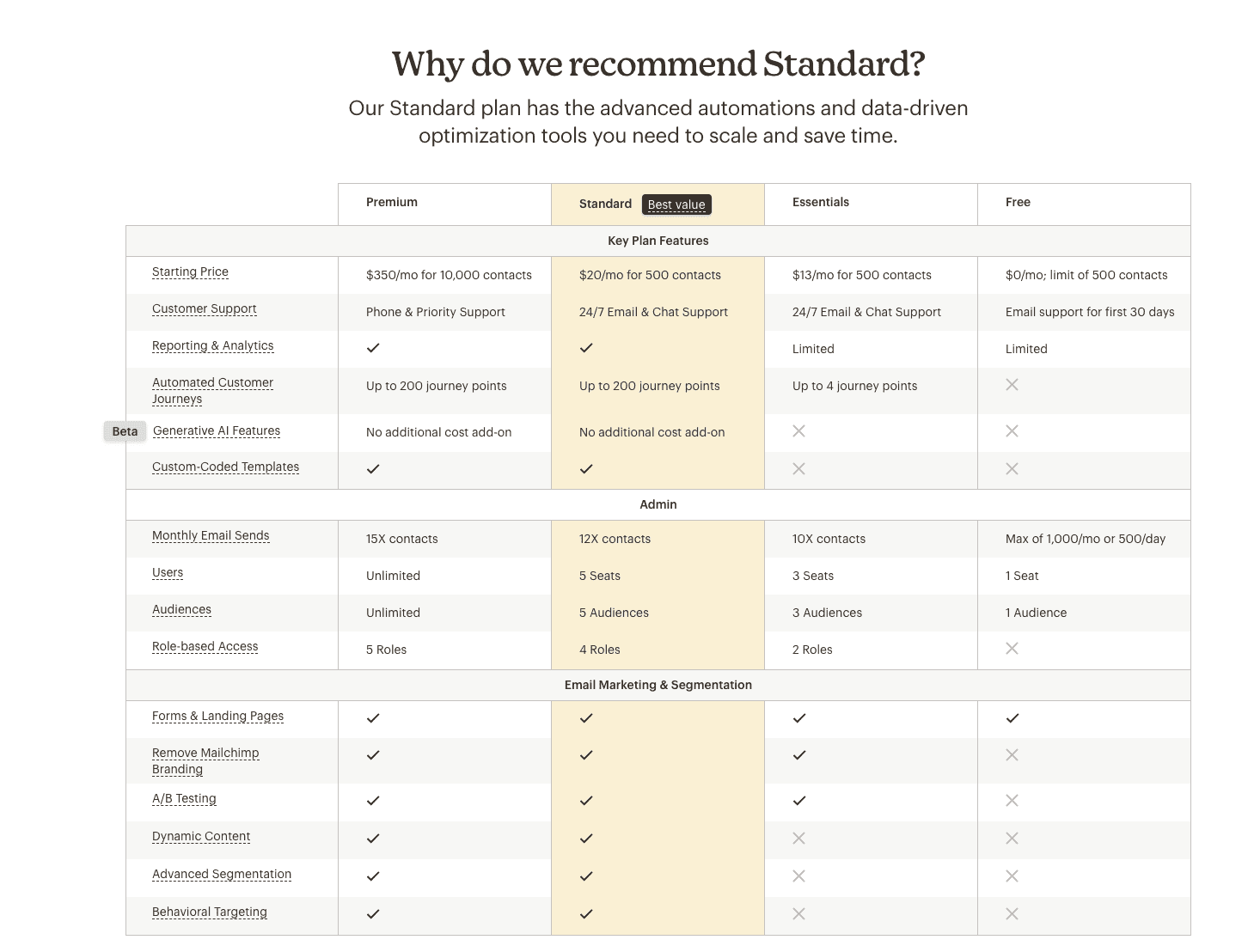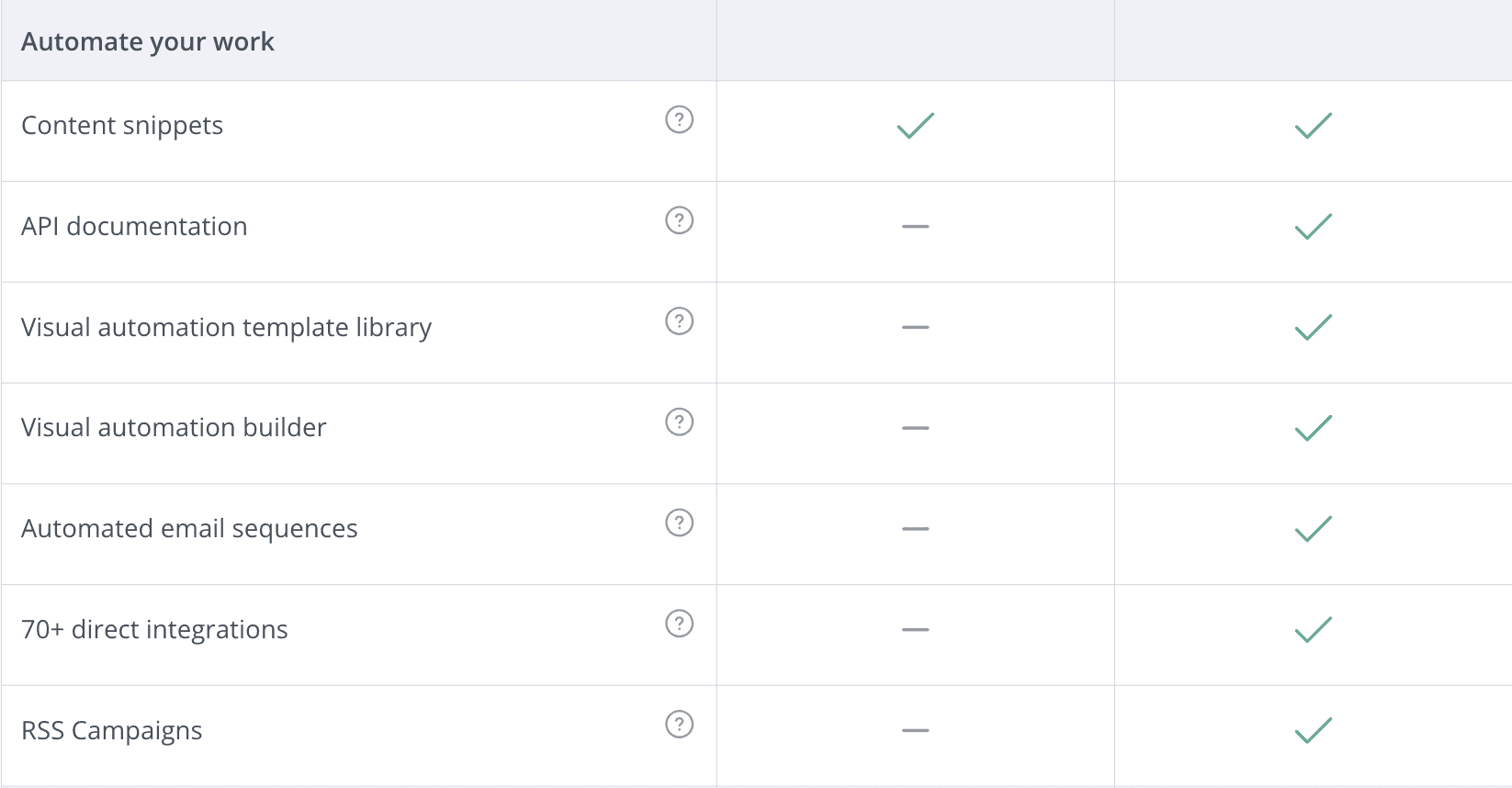
Finding the right email marketing platform for your blog is tough. You want to find a platform with all the right features for the right price.
So, to help you avoid spending too much time or money experimenting with each platform, this comparison should help.
Between prices, features, tools, customer support, and the many different options that are available between each email platform, this Kit review (previously Convertkit) and comparison to Mailchimp will help you decide if either service is right for you and your business.
This post may contain affiliate links, meaning I may receive a commission if you purchase through my links. I only recommend products I have personally tested or have thoroughly researched. All opinions are my own. Please read the full disclosure for more information.
Quick Summary
If you’re pressed for time, here’s a quick summary of which email platform is the best choice for bloggers.
Kit (best option for bloggers)
Kit (previously Convertkit) is by far the best option for bloggers as it offers basic features and advanced features specifically for content creators. It has a great user interface for ease of use. And, you can grow and monetize your email list using the free plan, and upgrade when you’re ready to scale.
- The free plan allows up to 1,000 subscribers
- Create unlimited forms and landing pages
- A/B split testing
- Send unlimited email broadcasts to your list (no matter the size)
- Schedule emails on the free plan.
There are also many other great features in the premium plans including automation and sequences which save you time and energy.
Here are some other ways to save time on your blog when creating Pinterest pins. Pins are also a great way for you to build and grow your email list. And, pins are also an excellent way to increase your website traffic.
If you want to learn how to get the most out of your Pinterest marketing, you will want to take a look at this awesome Pinterest strategy course by Carly Campbell. You can read my review of the course if you would like too.

Mailchimp (poor option for blogger, fair option for small-medium businesses)
Mailchimp is not a good option for bloggers. It has much more basic features, a difficult user interface, limited features on the free plans, and even some limitations on the paid plans. However, the available features included in Mailchimp may work well for small to medium businesses.
- Free plan up to 500 contacts
- Monthly email send limit is 1,000 sends and a daily limit of 500 (unclear as to what exactly this means)
- Create landing pages and pop-up forms
- Tag and segment your audience
- DOES NOT allow email scheduling in the Free plan
- DOES NOT allow A/B split testing in the Free plan
- Option to have SMS (additional cost)
There are other features included in the paid plans including automation and anything already included in the Free plan. Again, Mailchimp is not a good choice for bloggers but maybe a decent option for small businesses just starting out and working to scale up.

Another alternative to Converkit and Mailchimp that many bloggers have recommended and prefer is Mailerlite. The reason many bloggers prefer Mailerlite is due to its lower pricing.
What is Email Marketing?
Email marketing is when a business, or in this case a blogger, collects emails from their audience or customers. Once they have emails, they send out an email campaign to market a new product and advertise, or just to give their readers some value.
If you’re new to blogging, you’ve probably heard time and again, you need to build an “email list”. And there’s a reason why this is so important.
But why email marketing?
Because. Email marketing has a return on investment of up to 36x, meaning you have a much higher chance of making an income on email marketing versus other methods of monetizing.
Pretty impressive, right?
This means that it’s much more important to find the right email marketing software for your business, sooner rather than later. Otherwise, you may miss out on sales opportunities, and a chance to nurture your audience.
I’m not going to tell you which software is best for you and your business or situation because I don’t know your exact situation. However, I will give my honest opinion of Kit vs Mailchimp in this post, and give you all the numbers and information you need to decide.
I will also tell you why I prefer one over the other.
However, I do personally use Converkit currently and absolutely love it, and for good reason. But, I do mention a few other platforms that other bloggers in my Rank IQ mastermind recommend.
So, what is email marketing?
Email marketing is a way of earning a profit by collecting email addresses, and marketing to that email list. You can market affiliate products, sell your own courses, and otherwise provide value to your list.
Even small businesses can use an email service provider to keep in contact with previous customers and re-market to them. This is why you sometimes see follow-up emails, like abandoned carts email to encourage you to complete a buy, or remind you of a sale.
Many bloggers will create an email campaign and send out an automated email sequence to try and make affiliate sales. These automated sequences are perfect during holidays when customers are more likely and ready to buy.
Is Email Marketing Worth it?
Email marketing is absolutely worth the time and effort you put into it. The goal of having an email list is to nurture your audience and provide them with enough free value, that they eventually want to buy from you.
Because email marketing has such a high ROI, it’s important to dedicate and commit time to including it in your blogging efforts. If someone buys something from you once, whether it is your own product or just affiliate products, they are much more likely to buy from you again.
Plus, when you have nurtured your email list and given them something they find valuable, they are more likely to help you out. This can be a review of one of your products, feedback to improve a product, ideas for future blog posts and so much more.
A list isn’t just great for marketing too. They are your closest and most loyal supporters. So, it’s important to treat them as such.
Kit Features, Pricing Plans, and More: Pros and Cons
With this email marketing service, you can have up to 1,000 subscribers on their free plan using their most basic features. This means you can create unlimited forms and landing pages, you can use their landing page templates and form templates, send out unlimited emails, tag and segment your audience, and you can even sell digital products and subscriptions.
You can also use Kit’s free plan as long as you want. At least until you hit 1,000 subscribers.
All other features are included in their paid plans. And, if you are interested in trying out their paid plan, you can sign up for a 14-day free trial of their standard plan (Creator) and premium plans (Creator Pro).
The biggest differences between the paid plan and free plan include automated email sequences, visual automation builders, and free and paid recommendations.
This has allowed me to create my free Intro to Blogging Course and has helped me increase my email subscriber list. Plus, it has saved me so…much…time.
Also included are email templates which is another way for you to save even more time. There is a whole list of templates to choose from, but you can also create your own templates, which is perfect if you are planning upcoming email marketing campaigns. You can even upload an email template from an HTML code.
My favorite part about the paid plans is the email sequence and automation sequence features. The email automation sequence features have saved me so much time and energy. So I actually enjoy working on email campaigns whereas I found it to be a lot more work.
Plus, it allows me to create some great sales funnels with my affiliate links. So, if you use email marketing to monetize your blog, this can be a great way to start bringing in some more income.
One noticeable difference I found between the two email marketing tools is that Mailchimp offers SMS whereas Kit does not. But you can get a third-party platform to use SMS marketing with Converkit if this is something that you do want to include. Platforms like Simple Texting work well with Kit.
Here is a great review video of Kit (previously Convertkit) and a little introduction to seeing it in action.
Mailchimp Features, Pricing Plans, and More: Pros and Cons
One key feature that stands out with Mailchimp that Kit doesn’t have is the option to use SMS in addition to emails (not a deal breaker in my opinion as very few bloggers use SMS).
There is an additional monthly cost with using SMS but you can get a certain amount of credits each month depending on your needs.
What’s included
The basic features included in all plans are tagging and segmenting your list, landing pages and forms, and a few other things. The biggest thing that is not included is email scheduling. After reading a thread on Reddit, I noticed that this was something that used to be offered in the free plan but is no longer included (big turn-off for me).
If you are interested in a drag and drop editor, I believe, you can use a third-party integration called Unlayer.
Mailchimp also has a mobile app, whereas Kit does not. This is a great tool if you sell products directly from your emails as you can easily check your progress throughout the day and view your analytics from different campaigns more easily on your phone.
They have a 4.9 out of 5 review rate for the app, but from what I’ve read there are inconsistent responses.
Here is a review of Mailchimp by Jason. He goes into the top 5 things that he loves about Mailchimp and whether or not these features can help your business.
The biggest thing I’ve noticed about Mailchimp’s features is that it is very limited on what you can do with the free plan. You are limited to 500 contacts (or subscribers) and you are limited to how many emails you can send every month. It is not clear as to what exactly they mean by this because they state “1,000 sends per month” and a “daily limit of 500”.
This is clear as mud because I can’t tell if this means sending 500 emails out to a list of 500 each day (which makes sense for 1 email per subscriber per day), but then only 1,000 sends per month (which is what’s confusing).
Personally, I don’t like working with a company that does not use clarifying language when marketing their features. I find this to be a bit shady as some companies will use unclear language to take advantage of customers. I don’t think that is the intent here, but, nonetheless I find it to be rather unwelcoming.
One last thing of note with Mailchimp. They do offer an option to build and publish a website through them (available on all plans). But, I don’t like the idea of this because as a blogger you don’t own your website if they are the ones who own the domain.
As a small business owner though, this may be a decent option to get you started.
Personal Preference: Kit or Mailchimp?
Because I currently use Kit for my blog, I haven’t had much experience with Mailchimp. So, yes. I may be a bit biased.
However, when I was in the process of launching my blog in the beginning, I did try to work with Mailchimp and started with their free account. But because of the user interface and the very basic features, I quickly decided that it wasn’t for me so I immediately switched to Kit (formerly Convertkit at the time).
And, when I signed up for Converkit’s free version, I was immediately impressed and found that I preferred all the features that it had in the very generous free plan and the advanced features in the paid plan.
Over time as I learned more about these features and started working with them, I found that the value of even just the free version was impressive. So, when I decided I was finally tired of spending more time on my email marketing than I liked, I decided to upgrade to the paid version so I could offer more to my email subscribers.
It was worth every penny because I was able to create automation and sequences ahead of time so I could set it and forget it. If you want to save more time, I definitely recommend the paid plans.
I did find that there was a tiny bit of a learning curve to working with Kit, but a lot of that was from learning the navigation and working with email marketing in general. The bigger learning curve is understanding how to work with advanced automation.
I also found it very easy to create my opt-in forms and always thought they looked very professional. I still need to work on improving my landing pages, but if you prefer to create a landing page on your website and use a small inline form, you have the option to create more customized landing pages on your site.
However, my personal preference may differ from your own so you should always go with your gut. If you’re not quite sure, I’d suggest signing up for a free plan of each and mess with it some. Even if you only send out emails to yourself and your family, this gives you a chance to see firsthand which platform you prefer.
How to improve your email marketing strategy
If you want to learn more about how to improve your email marketing, I highly recommend getting this email course bundle by Heather Ritchie. Her Email Marketing Content Bundle is chock full of great and actionable tips to improve every part of your email system.
From increasing open and click rates, to writing great and engaging content, and even creating great automation and sales funnels. Her courses cover it all. She is a great teacher and I find her courses easy to learn from and take action on.
Immediately after implementing her tips, I saw an increase in both open rates, and click rates.
If you’re not quite ready to invest in a course or bundle, you can also sign up for my free Email Marketing Guide + Checklist. When you sign up you get a pdf download with a pre-broadcast checklist, and a guide to some quick tips to improve the different parts of your email.
Other posts you might be interested in
- 8 Simple Ways to Save Time and Money Creating Pinterest Pins on Canva
- Social Media Marketing In Business: Growth And Revenue
- What Skills Does a Digital Copywriter Need in 2023?
- The Only Legal Templates You Will Ever Need For Your Website and Business
- RankIQ Review: The Best SEO AI Tool For Bloggers To Rank (2023)
Other Blogger’s Opinions and Preferences: What Do the Pros Think?
I am a member of the RankIQ Facebook group, which is full of new and experienced bloggers. But they are all together for the same purpose, to increase traffic and work for the success of their blog.
So, I asked the group what they thought of Kit and Mailchimp, and this is what they had to say.
“Only used Mailchimp maybe like 6 years ago… I remember it being very basic”
“Used to use Mailchimp, very basic”
“I truly believe more creators should be on Convertkit [Kit]. It’s specifically made for them.”
“Mailchimp was the worst email service I ever used. Ugly, clunky, horrible. Convertkit [Kit] has the creator network which drives me hundreds of signups and they now have a way to monetize the email list.”
“Hated working in Mailchimp…so difficult. Switched to Convertkit [Kit].”
“Convertkit [Kit] and Mailchimp are so polar opposites. I don’t currently use either, but have used both in the past. Mailchimp is much more basic than Converkit.”
Unfortunately, I did not really notice many positive experiences with Mailchimp. Everyone who responded to my poll reported that they disliked using Mailchimp because it was too basic. And no one mentioned any opinion regarding the pricing of Mailchimp.
Several responses did mention they thought Kit was higher priced than other other platforms. But, you also expect to get what you pay for too. And email marketing is no different.
And those who have used Converkit in the past, or still use it did say they really loved it and all the features that come with it.
One note I did want to mention though in addition to comparing Kit and Mailchimp.
Several comments did say that they like using Mailerlite and Flowdesk. One blogger said she uses Flodesk as it is more affordable, but that it is a bit basic.
Final thoughts?
I absolutely love working with Kit. I have loved in since the beginning and find that it is worth every penny. It is perfect for content creators making it the better of the two options for bloggers.
But, that doesn’t mean that Kit is for you. What do you think, do you like Kit, or do you use another platform?



I’ve never used tools like Convertkit or others. That sounds good and makes the job easier, I’ll look into it further. Thank you for your explanation.